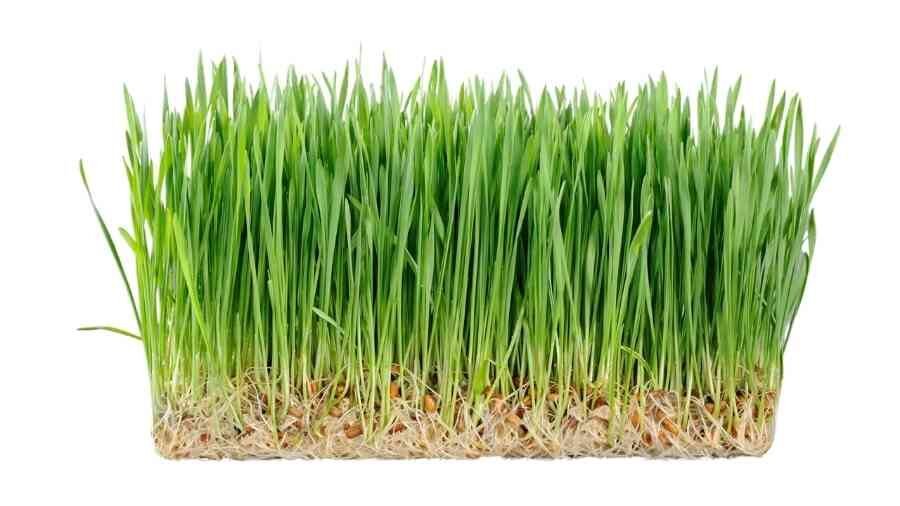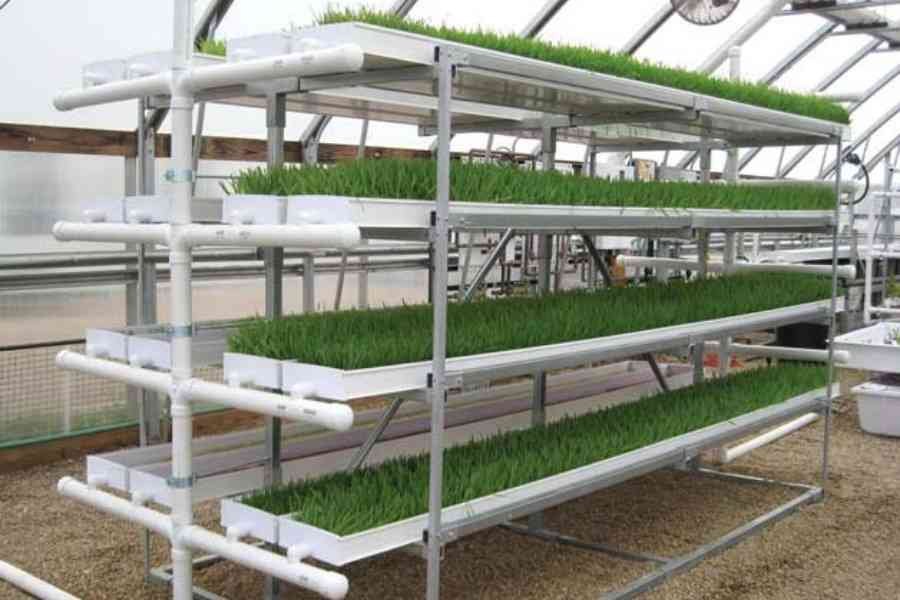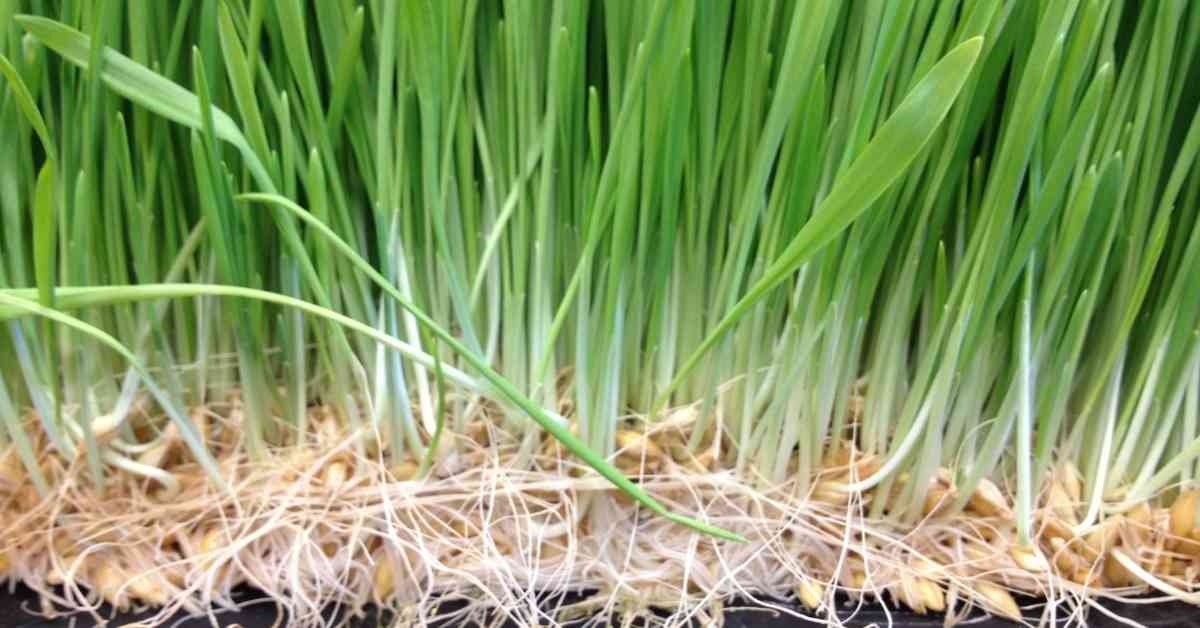Hydroponic fodder is a type of feed produced by germinating seeds in a hydroponic system. Hydroponic fodder is an exciting and unique way of growing grass. It is a process that uses water to grow grass rather than soil. We’ll explain what it is, how it works, and some of the benefits you can expect.
What is fodder?
Fodder refers to food given to livestock, particularly cattle, horses, chickens, and sheep. The term comes from the Old English word “fodian,” which means “to feed.” There are a variety of different types of fodder that can be used to feed livestock.
One of the most common is hay, which is dried grass that has been cut and baled. Hay is a nutrient-rich winter feed for cattle. Silage is fermented preserved grass. Silage is high in protein and is often used as a summer food for cattle.
Grain can also be used as fodder and is often mixed with hay or silage to create a balanced diet for livestock. Farmers can ensure that their livestock remains healthy and well-nourished by providing their animals with various types of fodder.

Types Of Fodder
All types of fodder can be divided into two major categories; temporary and permanent.
Temporary fodder
Three main categories of temporary crops are produced extensively with numerous cuttings each year:
- Grasses, including cereals
- Legumes, including pulses
- Root crops
- Trees
Permanent fodder
Land used for herbaceous forage crops permanently (for five years or more, i.e., wild prairie or grazing land) is referred to as having permanent fodder crops and may also include some portions of forest land if used for grazing.
What is Hydroponic Fodder?
The hydroponic fodder used as livestock feed is young, tender grass grown from cereal grain, mostly barley. It is also rich in nutrients, making it an excellent choice for those looking for a nutritious and healthy diet. In addition, no soil is required for the hydroponic fodder system, which cultivates the grass in a nutrient-rich solution.
This method of growing grass is highly efficient, as it requires less water and space than traditional methods. Additionally, the hydroponic fodder system can grow grass all year round, regardless of the weather conditions. As a result, a hydroponic fodder system is an excellent option for those looking for a reliable and affordable source of livestock feed.
The hydroponic farming system provides the ideal growing environment for the seeds, allowing them to germinate quickly and produce a high yield of nutritious foliage.
In addition to providing a nutritious source of food for livestock, hydroponic fodder can also help reduce the amount of manure produced on farms. This is because the foliage of hydroponic plants contains less nitrogen than traditional feeds. As a result, farmers who use hydroponic fodder can help reduce their operations’ environmental impact while also providing a healthy diet for their animals.

Hydroponic Fodder Seeds List
A wide variety of seeds and plants can be used to produce hydroponic fodder, including:
- Barley
- Wheat
- Alfalfa
- Clover
- Corn
- Cowpeas
- Oats,
- Sorghum
- Rye
- Triticale
The specific seeds and plants that are used will often depend on the type of livestock that will be consuming the fodder. For example, cattle may be fed hydroponic barley, while pigs might be fed hydroponic wheat.
How to Produce Hydroponic Fodder?
Fodder is produced by germinating seeds in a moist growing medium, such as stale or recycled grey water, for 7-10 days. The resulting sprouts are then harvested and fed to livestock. Hydroponic fodder production is an efficient way to provide fresh, nutrient-rich animal feed while reducing waste.
You should know a few things before installing a hydroponic fodder system on your farm or ranch.
- Size and complexity affect the cost of a hydroponic fodder system.
- Large-scale production will cost several hundred dollars in equipment and supplies.
- You’ll need space to grow and store fodder.
- Growing hydroponic fodder requires plant care knowledge, so do your homework first.
Consider the following when choosing a hydroponic fodder system:
- Plant type
- Available space
- Expenses.
To produce hydroponic fodder, you will need the following:
- A container (e.g., a plastic bin) with holes drilled in the bottom for drainage
- Hydroponic growing medium (e.g., rock wool)
- A water pump
- PVC pipes
- Air pumps
- A timer
- Spray bottle
- Seeds suitable for sprouting (e.g., wheat, barley, oats, rye)
You can also buy a complete fodder system from your local market or online like amazon. If you’re new to fodder growing, start small before expanding. This will teach you hydroponic fodder equipment and procedures. Then, after growing fodder successfully on a small scale, you can expand.
Hydroponic fodder tips:
- As you gain experience, expand your system.
- Fresh water and nutrients work best.
- Ensure your plants get enough light and air.
- Young, tender fodder is the tastiest and most nutritious.

Advantages Of Hydroponic Fodder
Hydroponic fodder has several potential benefits to consider.
- Hydroponic fodder can be produced year-round.
- Hydroponic fodder can be produced even in regions with harsh winters.
- You consistently supply fresh, nutritious fodder, even when pasture grasses are unavailable.
- Hydroponic fodder is typically very high in vitamins and minerals, which can help to improve your livestock’s overall health.
Disadvantages/Risks Of Hydroponic Fodder
However, hydroponic fodder can also be expensive, requiring significant space and equipment. As a result, it may only be practical for high-skilled farmers. The system cost is also high. Large enterprises incur high labor costs to prepare, maintain, harvest, and feed fodder. Extra care needs to maintain moderate temperatures and maintain humidity, but clean water is needed for hydroponics.
FAQs about Hydroponic Fodder
How nutritious is hydroponic fodder?
Hydroponic fodder is a rich source of vitamin A, vitamin E, vitamin C, thiamin, riboflavin, niacin, biotin, free folic acid, anti-oxidants like β-carotene (Finney, 1982; Cuddeford, 1989; Naik et al., 2015) and minerals (Bhise et al., 1988; Chung et al., 1989; Fazaeli et al., 2012).
How long does fodder take to grow?
The best thing is that the entire process, beginning with the sprout and ending with fodder that is ready to be fed, only takes six to eight days. Quick! Because the animals consume everything, even the sprouts, the seeds, and the roots, there is no food waste!
How long does hydroponic fodder last?
After nine days, the fodder’s nutritious content starts to diminish and fiber develops. Feed this to livestock together with other food and dry forage.
How often should I water my hydroponic fodder?
The seeds should be watered 4-6 times each day until the water reaches halfway down the channel. Once the water starts flowing, this should take 2-3 minutes in a 12′ channel.
How do you keep mold from growing on fodder?
Maintain a temperature of 60–70 degrees for the feed. Mold will start to develop on a windowsill if it is cold and drafty. After watering, thoroughly drain the trays. Because chickens prefer sprouted grain to a lush grassy mat, you should let the grains sprout for three to four days before feeding them to chickens.
Is hydroponic fodder profitable?
There are three options you have to feed your livestock;
- You can graze, pasture, or
- Cultivate your hay or silage, or
- Buy hay or other forages, or
- Grow hydroponically, or
- Feed grains directly.
Your question is, which makes the most benefits? For example, in a hydroponic system, one ‘pod’ starting with 104 lbs. seed would generate 60-80 lbs; This is 2/3 of a 125-pound bale of hay (alfalfa, grain, or grass) per pod, which costs $12 to $18/bale. Therefore, a hydroponic system must cost less than $8-$12/pod/year, including infrastructure, seed, and labor.
Considering the cost of seed at 18 cents/pound (not infrastructure or staffing), the hydroponic cost of production would be $461/ton of hay (90%DM). So it could be double with others’ expense. The cost of production per pound or ton produced is likely to be greater than the feed grain equivalent. Hydroponic forage appeals to individuals who want to be self-sufficient in feed supplies, but its production, quality, and expenses are unfavorable. That’s why some think that hydropic fodder is only for those with skill and enterprise.
Is Hydroponic Fodder Good For Chicken?
Hydroponic fodder is a type of farming that doesn’t require soil. Instead, the plants are grown in water that’s enriched with nutrients. People believe this food is good for chickens because it’s more efficient, and there’s no risk of contamination from bacteria or pesticides.
However, there are some drawbacks to hydroponic fodder. For one, it can be more expensive if you need more experience. Additionally, the quality of the fodder can vary depending on the system used to grow it. Therefore, if you’re thinking about feeding your chickens hydroponic fodder, it’s essential to research to make sure it’s the right choice for your flock.
Is Hydroponic Fodder Good For Horses?
The addition of fodder to a horse’s diet is highly beneficial. Hydroponic horse feed is healthier and cheaper than hay, alfalfa cubes, and other dry feeds. Sprouts cost $0.03–$0.05 per lb. So start saving on horse feed today, with rising costs. After all, before deciding whether or not to add hydroponic fodder to your horse’s diet.
Verdict
Hydroponic fodder is becoming increasingly popular, as it has a lot of benefits for both the farmer and the livestock. If you’re interested in learning more about hydroponic fodder, try and let us know. If you have questions you can share your thoughts.
